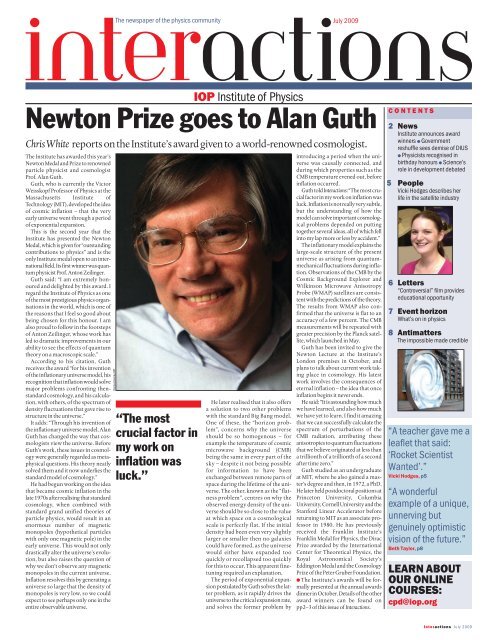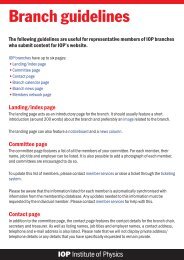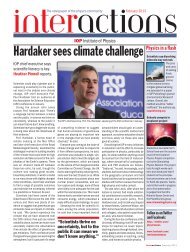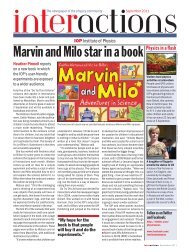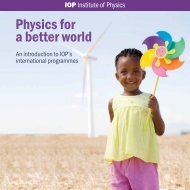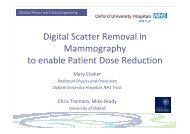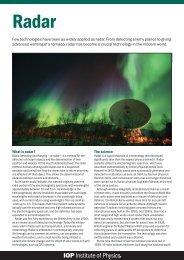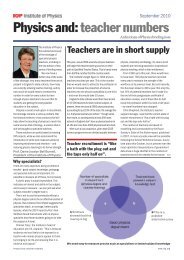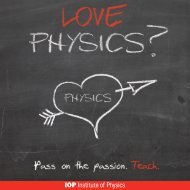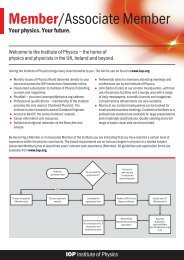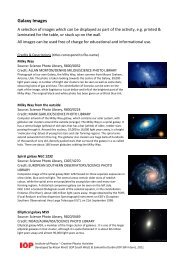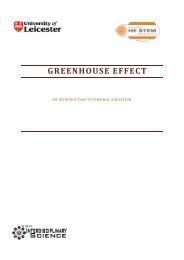Newton Prize goes to Alan Guth - Institute of Physics
Newton Prize goes to Alan Guth - Institute of Physics
Newton Prize goes to Alan Guth - Institute of Physics
Create successful ePaper yourself
Turn your PDF publications into a flip-book with our unique Google optimized e-Paper software.
The newspaper <strong>of</strong> the physics community July 2009<br />
<strong>New<strong>to</strong>n</strong> <strong>Prize</strong> <strong>goes</strong> <strong>to</strong> <strong>Alan</strong> <strong>Guth</strong><br />
Chris White reports on the <strong>Institute</strong>’s award given <strong>to</strong> a world-renowned cosmologist.<br />
The <strong>Institute</strong> has awarded this year’s<br />
<strong>New<strong>to</strong>n</strong> Medal and <strong>Prize</strong> <strong>to</strong> renowned<br />
particle physicist and cosmologist<br />
Pr<strong>of</strong>. <strong>Alan</strong> <strong>Guth</strong>.<br />
<strong>Guth</strong>, who is currently the Vic<strong>to</strong>r<br />
Weisskopf Pr<strong>of</strong>essor <strong>of</strong> <strong>Physics</strong> at the<br />
Massachusetts <strong>Institute</strong> <strong>of</strong><br />
Technology (MIT), developed the idea<br />
<strong>of</strong> cosmic inflation – that the very<br />
early universe went through a period<br />
<strong>of</strong> exponential expansion.<br />
This is the second year that the<br />
<strong>Institute</strong> has presented the <strong>New<strong>to</strong>n</strong><br />
Medal, which is given for “outstanding<br />
contributions <strong>to</strong> physics” and is the<br />
only <strong>Institute</strong> medal open <strong>to</strong> an international<br />
field. Its first winner was quantum<br />
physicist Pr<strong>of</strong>. An<strong>to</strong>n Zeilinger.<br />
<strong>Guth</strong> said: “I am extremely honoured<br />
and delighted by this award. I<br />
regard the <strong>Institute</strong> <strong>of</strong> <strong>Physics</strong> as one<br />
<strong>of</strong> the most prestigious physics organisations<br />
in the world, which is one <strong>of</strong><br />
the reasons that I feel so good about<br />
being chosen for this honour. I am<br />
also proud <strong>to</strong> follow in the footsteps<br />
<strong>of</strong> An<strong>to</strong>n Zeilinger, whose work has<br />
led <strong>to</strong> dramatic improvements in our<br />
ability <strong>to</strong> see the effects <strong>of</strong> quantum<br />
theory on a macroscopic scale.”<br />
According <strong>to</strong> his citation, <strong>Guth</strong><br />
receives the award “for his invention<br />
<strong>of</strong> the inflationary universe model, his<br />
recognition that inflation would solve<br />
major problems confronting thenstandard<br />
cosmology, and his calculation,<br />
with others, <strong>of</strong> the spectrum <strong>of</strong><br />
density fluctuations that gave rise <strong>to</strong><br />
structure in the universe.”<br />
It adds: “Through his invention <strong>of</strong><br />
the inflationary universe model, <strong>Alan</strong><br />
<strong>Guth</strong> has changed the way that cosmologists<br />
view the universe. Before<br />
<strong>Guth</strong>’s work, these issues in cosmology<br />
were generally regarded as metaphysical<br />
questions. His theory neatly<br />
solved them and it now underlies the<br />
standard model <strong>of</strong> cosmology.”<br />
He had begun working on the idea<br />
that became cosmic inflation in the<br />
late 1970s after realising that standard<br />
cosmology, when combined with<br />
standard grand unified theories <strong>of</strong><br />
particle physics, would result in an<br />
enormous number <strong>of</strong> magnetic<br />
monopoles (hypothetical particles<br />
with only one magnetic pole) in the<br />
early universe. This would not only<br />
drastically alter the universe’s evolution,<br />
but also raises the question <strong>of</strong><br />
why we don’t observe any magnetic<br />
monopoles in the current universe.<br />
Inflation resolves this by generating a<br />
universe so large that the density <strong>of</strong><br />
monopoles is very low, so we could<br />
expect <strong>to</strong> see perhaps only one in the<br />
entire observable universe.<br />
Donna Coveney/MIT<br />
“The most<br />
crucial fac<strong>to</strong>r in<br />
my work on<br />
inflation was<br />
luck.”<br />
He later realised that it also <strong>of</strong>fers<br />
a solution <strong>to</strong> two other problems<br />
with the standard Big Bang model.<br />
One <strong>of</strong> these, the “horizon problem”,<br />
concerns why the universe<br />
should be so homogenous – for<br />
example the temperature <strong>of</strong> cosmic<br />
microwave background (CMB)<br />
being the same in every part <strong>of</strong> the<br />
sky – despite it not being possible<br />
for information <strong>to</strong> have been<br />
exchanged between remote parts <strong>of</strong><br />
space during the lifetime <strong>of</strong> the universe.<br />
The other, known as the “flatness<br />
problem”, centres on why the<br />
observed energy density <strong>of</strong> the universe<br />
should be so close <strong>to</strong> the value<br />
at which space on a cosmological<br />
scale is perfectly flat. If the initial<br />
density had been even very slightly<br />
larger or smaller then no galaxies<br />
could have formed, as the universe<br />
would either have expanded <strong>to</strong>o<br />
quickly or recollapsed <strong>to</strong>o quickly<br />
for this <strong>to</strong> occur. This apparent finetuning<br />
required an explanation.<br />
The period <strong>of</strong> exponential expansion<br />
postulated by <strong>Guth</strong> solves the latter<br />
problem, as it rapidly drives the<br />
universe <strong>to</strong> the critical expansion rate,<br />
and solves the former problem by<br />
introducing a period when the universe<br />
was causally connected, and<br />
during which properties such as the<br />
CMB temperature evened out, before<br />
inflation occurred.<br />
<strong>Guth</strong> <strong>to</strong>ld Interactions: “The most crucial<br />
fac<strong>to</strong>r in my work on inflation was<br />
luck. Inflation is not really very subtle,<br />
but the understanding <strong>of</strong> how the<br />
model can solve important cosmological<br />
problems depended on putting<br />
<strong>to</strong>gether several ideas, all <strong>of</strong> which fell<br />
in<strong>to</strong> my lap more or less by accident.”<br />
The inflationary model explains the<br />
large-scale structure <strong>of</strong> the present<br />
universe as arising from quantummechanical<br />
fluctuations during inflation.<br />
Observations <strong>of</strong> the CMB by the<br />
Cosmic Background Explorer and<br />
Wilkinson Microwave Anisotropy<br />
Probe (WMAP) satellites are consistent<br />
with the predictions <strong>of</strong> the theory.<br />
The results from WMAP also confirmed<br />
that the universe is flat <strong>to</strong> an<br />
accuracy <strong>of</strong> a few percent. The CMB<br />
measurements will be repeated with<br />
greater precision by the Planck satellite,<br />
which launched in May.<br />
<strong>Guth</strong> has been invited <strong>to</strong> give the<br />
<strong>New<strong>to</strong>n</strong> Lecture at the <strong>Institute</strong>’s<br />
London premises in Oc<strong>to</strong>ber, and<br />
plans <strong>to</strong> talk about current work taking<br />
place in cosmology. His latest<br />
work involves the consequences <strong>of</strong><br />
eternal inflation – the idea that once<br />
inflation begins it never ends.<br />
He said: “It is as<strong>to</strong>unding how much<br />
we have learned, and also how much<br />
we have yet <strong>to</strong> learn. I find it amazing<br />
that we can successfully calculate the<br />
spectrum <strong>of</strong> perturbations <strong>of</strong> the<br />
CMB radiation, attributing these<br />
anisotropies <strong>to</strong> quantum fluctuations<br />
that we believe originated at less than<br />
a trillionth <strong>of</strong> a trillionth <strong>of</strong> a second<br />
after time zero.”<br />
<strong>Guth</strong> studied as an undergraduate<br />
at MIT, where he also gained a master’s<br />
degree and then, in 1972, a PhD.<br />
He later held postdoc<strong>to</strong>ral positions at<br />
Prince<strong>to</strong>n University, Columbia<br />
University, Cornell University and the<br />
Stanford Linear Accelera<strong>to</strong>r before<br />
returning <strong>to</strong> MIT as an associate pr<strong>of</strong>essor<br />
in 1980. He has previously<br />
received the Franklin <strong>Institute</strong>’s<br />
Franklin Medal for <strong>Physics</strong>, the Dirac<br />
<strong>Prize</strong> awarded by the International<br />
Center for Theoretical <strong>Physics</strong>, the<br />
Royal Astronomical Society’s<br />
Edding<strong>to</strong>n Medal and the Cosmology<br />
<strong>Prize</strong> <strong>of</strong> the Peter Gruber Foundation.<br />
● The <strong>Institute</strong>’s awards will be formally<br />
presented at the annual awards<br />
dinner in Oc<strong>to</strong>ber. Details <strong>of</strong> the other<br />
award winners can be found on<br />
pp2–3 <strong>of</strong> this issue <strong>of</strong> Interactions.<br />
CONTENTS<br />
2 News<br />
<strong>Institute</strong> announces award<br />
winners ● Government<br />
reshuffle sees demise <strong>of</strong> DIUS<br />
● Physicists recognised in<br />
birthday honours ● Science’s<br />
role in development debated<br />
5 People<br />
Vicki Hodges describes her<br />
life in the satellite industry<br />
6 Letters<br />
“Controversial” film provides<br />
educational opportunity<br />
7 Event horizon<br />
What’s on in physics<br />
8 Antimatters<br />
The impossible made credible<br />
“A teacher gave me a<br />
leaflet that said:<br />
‘Rocket Scientist<br />
Wanted’.”<br />
Vicki Hodges, p5<br />
“A wonderful<br />
example <strong>of</strong> a unique,<br />
unnerving but<br />
genuinely optimistic<br />
vision <strong>of</strong> the future.”<br />
Beth Taylor, p8<br />
LEARN ABOUT<br />
OUR ONLINE<br />
COURSES:<br />
cpd@iop.org<br />
Interactions July 2009
2 news<br />
AWARDS<br />
The following awards have been announced by the <strong>Institute</strong>:<br />
Business and Innovation Medal<br />
Pr<strong>of</strong>. Sir Richard Friend (<strong>to</strong>p) <strong>of</strong> the University <strong>of</strong><br />
Cambridge and Cambridge Display Technology<br />
(CDT), and David Fyfe <strong>of</strong> CDT for guiding CDT <strong>to</strong> a<br />
pre-eminent position in the development <strong>of</strong> lightemitting<br />
polymers and <strong>of</strong> the technology for flatpanel<br />
displays and lighting.<br />
Dirac Medal<br />
Pr<strong>of</strong>. Michael Cates <strong>of</strong> the University <strong>of</strong><br />
Edinburgh for pioneering work in the theoretical<br />
physics <strong>of</strong> s<strong>of</strong>t materials, particularly in relation <strong>to</strong><br />
their flow behaviour.<br />
Faraday Medal<br />
Pr<strong>of</strong>. Donal D C Bradley <strong>of</strong> Imperial College London<br />
for his pioneering work in the field <strong>of</strong> “plastic<br />
electronics”. His experimental investigations have<br />
significantly advanced our understanding <strong>of</strong> the<br />
physics <strong>of</strong> conjugated polymers as<br />
semiconduc<strong>to</strong>rs and helped <strong>to</strong> demonstrate their<br />
widespread potential.<br />
<strong>Institute</strong> awards are announced<br />
A leading Malaysian physicist who is<br />
the direc<strong>to</strong>r <strong>of</strong> the United Nations<br />
Office for Outer Space Affairs<br />
(UNOOSA) is among those awarded<br />
medals this year by the <strong>Institute</strong>.<br />
Pr<strong>of</strong>. Datuk Mazlan Othman was<br />
awarded the President’s Medal in<br />
recognition <strong>of</strong> her work in developing<br />
astronomy education in Malaysia and<br />
her leading national and international<br />
role in space science, both through<br />
her setting up <strong>of</strong> the Malaysian Space<br />
Agency and in her UN role.<br />
The recipient <strong>of</strong> the President’s<br />
Medal is personally chosen by the<br />
serving president <strong>of</strong> the <strong>Institute</strong>, currently<br />
Pr<strong>of</strong>. Jocelyn Bell Burnell. It will<br />
be given at the <strong>Institute</strong>’s awards dinner<br />
on 15 Oc<strong>to</strong>ber, when the <strong>Institute</strong>’s<br />
other medals and prizes will<br />
also be presented.<br />
Othman was educated in Malaysia<br />
and studied physics at the University<br />
<strong>of</strong> Otago, New Zealand, becoming the<br />
first woman at the university <strong>to</strong><br />
receive a PhD in astrophysics. She<br />
The President’s Medal was given<br />
<strong>to</strong> Pr<strong>of</strong>. Datuk Mazlan Othman.<br />
returned <strong>to</strong> Malaysia as her country’s<br />
first astrophysicist and set about<br />
establishing university courses in<br />
astronomy and labora<strong>to</strong>ries for<br />
undergraduate and postgraduate<br />
training, as well as promoting the<br />
space sciences.<br />
Her campaigning <strong>to</strong> promote public<br />
awareness <strong>of</strong> astronomy led <strong>to</strong> a<br />
position with the prime minister’s<br />
department <strong>to</strong> direct the design and<br />
construction <strong>of</strong> the National Planetarium.<br />
Othman also established the<br />
nation’s Space Science Studies Division<br />
and as direc<strong>to</strong>r-general, initiated<br />
the National Microsatellite Programme<br />
which gave birth <strong>to</strong><br />
TiungSAT-1.<br />
In 1999 Othman was appointed as<br />
the direc<strong>to</strong>r <strong>of</strong> UNOOSA and in 2002<br />
she returned <strong>to</strong> Malaysia <strong>to</strong> set up and<br />
lead the National Space Agency,<br />
returning <strong>to</strong> the post <strong>of</strong> direc<strong>to</strong>r <strong>of</strong><br />
UNOOSA in 2007.<br />
● Details <strong>of</strong> the awards made this year<br />
are shown on this page and p3. Fuller<br />
citations for all <strong>of</strong> the awards are available<br />
on the <strong>Institute</strong>’s website at<br />
www.iop.org/activity/awards.<br />
Connor Cahill<br />
Glazebrook Medal<br />
Pr<strong>of</strong>. Sir Peter Knight <strong>of</strong> Imperial College London<br />
for his outstanding contributions <strong>to</strong> physics in the<br />
UK and globally through his scholarship as a<br />
pre-eminent a<strong>to</strong>mic and molecular optics<br />
theoretician and as a charismatic and effective<br />
leader <strong>of</strong> research and research organisations.<br />
Chadwick Medal and <strong>Prize</strong><br />
Pr<strong>of</strong>. Tejinder S Virdee <strong>of</strong> Imperial College<br />
London for his crucial role in the design and<br />
construction <strong>of</strong> the Compact Muon Solenoid<br />
experiment, one <strong>of</strong> the main experiments that<br />
starts operation at the Large Hadron Collider<br />
(LHC) this year.<br />
Joule Medal and <strong>Prize</strong><br />
Pr<strong>of</strong>. Jenny Nelson <strong>of</strong> Imperial College London for<br />
her penetrating theoretical analyses <strong>of</strong> a range <strong>of</strong><br />
pho<strong>to</strong>voltaic materials and devices that have had<br />
a pr<strong>of</strong>ound influence on solar-cell design.<br />
Mott Medal and <strong>Prize</strong><br />
Pr<strong>of</strong>. Gillian Gehring <strong>of</strong> the University <strong>of</strong> Sheffield<br />
for her seminal contributions <strong>to</strong> magnetism.<br />
Payne-Gaposchkin Medal and <strong>Prize</strong><br />
Pr<strong>of</strong>. Eric Priest <strong>of</strong> the University <strong>of</strong> St Andrews<br />
for his numerous major contributions <strong>to</strong> many <strong>of</strong><br />
the unsolved problems in solar physics, including<br />
magnetic reconnection, coronal heating, phasingmixing<br />
<strong>of</strong> magne<strong>to</strong>hydrodynamic waves and solar<br />
flares.<br />
FameLab winner Tom Whyntie performs with Georgina Humphreys, winner <strong>of</strong> the Edinburgh regional heat.<br />
FameLab winner is a physicist<br />
By Heather Pinnell<br />
A young physicist based at CERN has<br />
won this year’s NESTA FameLab competition,<br />
which aimed <strong>to</strong> find promising<br />
new science communica<strong>to</strong>rs. Tom<br />
Whyntie, a PhD student at Imperial<br />
College London, <strong>to</strong>ok the first prize <strong>of</strong><br />
£10 000 after competing against nine<br />
other regional winners in the grand<br />
final at the Cheltenham Science Festival<br />
in June.<br />
All <strong>of</strong> the contenders had <strong>to</strong> impress<br />
the judges with an entertaining but<br />
scientifically accurate presentation<br />
that would communicate well <strong>to</strong> a<br />
general audience, and they had just<br />
three minutes in which <strong>to</strong> do it.<br />
Whyntie, a member <strong>of</strong> the <strong>Institute</strong><br />
who works on the Compact Muon<br />
Solenoid experiment at CERN,<br />
attempted <strong>to</strong> convince the audience<br />
that the money spent on the Large<br />
Hadron Collider would not be wasted<br />
even if researchers did not find the<br />
Higgs boson, as this would be a great<br />
result, he said.<br />
The 10 finalists were selected after<br />
initial auditions and regional heats in<br />
Bris<strong>to</strong>l, Edinburgh, London, Manchester<br />
and Oxford, where each had<br />
<strong>to</strong> give a three-minute talk on a theme<br />
that differed from the one that they<br />
chose <strong>to</strong> talk on in Cheltenham. All 10<br />
won the chance <strong>to</strong> attend a weekend<br />
master class in science communication.<br />
The Master Class prize went <strong>to</strong><br />
<strong>Institute</strong> member Andrew Pontzen<br />
for showing the most generosity and<br />
adaptability during the weekend.<br />
The runner-up was undergraduate<br />
chemistry student Alistair Linsell,<br />
who won a £5000 prize. Third place<br />
and a £750 prize went <strong>to</strong> Simon Foster,<br />
who has a PhD in solar-terrestrial<br />
physics and is now a science teacher in<br />
London. Both they and Whyntie will<br />
each have a slot in Channel 4’s Three<br />
Minute Wonder series, with Whyntie<br />
winning an additional slot.<br />
Head judge Kathy Sykes said: “We<br />
were very impressed with all <strong>of</strong> the<br />
finalists but Tom really s<strong>to</strong>od out due<br />
<strong>to</strong> his remarkable stage presence, and<br />
the fact that he tackled an incredibly<br />
complex scientific process. It’s difficult<br />
<strong>to</strong> make the null hypothesis interesting<br />
and engaging for the general public.<br />
However he managed <strong>to</strong> do this<br />
successfully and <strong>to</strong> inject fabulous<br />
humour in<strong>to</strong> his talk at the same time.”<br />
Whyntie said that being in the competition<br />
had opened up a host <strong>of</strong> new<br />
opportunities for him and it had been<br />
a great pleasure <strong>to</strong> perform at Cheltenham<br />
and <strong>to</strong> talk about a subject he<br />
was passionate about. “Many people<br />
are afraid <strong>to</strong> say that they don’t know.<br />
My aim is <strong>to</strong> challenge people and help<br />
them <strong>to</strong> find out more,” he said.<br />
Interactions July 2009
news<br />
3<br />
Change comes <strong>to</strong> DIUS<br />
Chris White reports on a departmental move for science.<br />
By Chris White<br />
Nine <strong>of</strong> the <strong>Institute</strong>’s members have<br />
been recognised in the Queen’s Birthday<br />
Honours for their contributions<br />
<strong>to</strong> science, education and industry.<br />
Pr<strong>of</strong>. Bill Wakeham, vice-chancellor<br />
<strong>of</strong> the University <strong>of</strong> Southamp<strong>to</strong>n,<br />
received a knighthood for services <strong>to</strong><br />
chemical engineering and <strong>to</strong> education.<br />
Last year Wakeham chaired the<br />
Research Councils UK’s review <strong>of</strong> the<br />
health <strong>of</strong> UK physics. He was<br />
appointed as vice-chancellor at<br />
Southamp<strong>to</strong>n in 2001 and also holds<br />
a position as a visiting pr<strong>of</strong>essor at<br />
Imperial College London.<br />
A CBE was awarded <strong>to</strong> Peter Saraga,<br />
immediate past president <strong>of</strong> the <strong>Institute</strong><br />
and vice-president <strong>of</strong> the Royal<br />
Academy <strong>of</strong> Engineering, for services<br />
<strong>to</strong> science and <strong>to</strong> engineering. Saraga<br />
was the managing direc<strong>to</strong>r <strong>of</strong> Phillips<br />
Research Labora<strong>to</strong>ries UK until 2002.<br />
He had previously received an OBE in<br />
the 2003 New Year Honours.<br />
DIUS<br />
Lord Drayson stays as science minister, but in a new department.<br />
The Department for Innovation Universities<br />
and Skills has been scrapped<br />
just two years after it was created. It<br />
has merged with the Department for<br />
Business, Enterprise and Regula<strong>to</strong>ry<br />
Reform <strong>to</strong> produce a new Department<br />
for Business, Innovation and<br />
Skills (<strong>to</strong> be known as BIS).<br />
Responsibility for science and for<br />
higher education will be taken over by<br />
Lord Mandelson, who becomes Secretary<br />
<strong>of</strong> State for the new department.<br />
Lord Drayson retains his position<br />
as minister for science and innovation<br />
and David Lammy will keep his<br />
role as minister for higher education<br />
and intellectual property within the<br />
new department.<br />
Beth Taylor, the <strong>Institute</strong>’s direc<strong>to</strong>r<br />
<strong>of</strong> communications said: “As the<br />
responsibility for science and its<br />
budget moves departments, it’s crucial<br />
that money for science remains<br />
ring-fenced and, if it is <strong>to</strong> be returned<br />
<strong>to</strong> the department focused on business<br />
and enterprise, it does not result<br />
in additional pressure on the research<br />
councils <strong>to</strong> deliver more short-term,<br />
mission-based research.<br />
“Scientists need the freedom <strong>to</strong><br />
undertake fundamental, curiositydriven<br />
research if they are <strong>to</strong> deliver the<br />
significant breakthroughs needed <strong>to</strong><br />
face the challenges <strong>of</strong> the 21st century.”<br />
Other ministerial appointments in<br />
the new department include Kevin<br />
Brennan, the MP for Cardiff West who<br />
takes up the position <strong>of</strong> minister for<br />
further education, skills, apprenticeships<br />
and consumer affairs; and Lord<br />
Carter, who becomes minister for<br />
communications, technology and<br />
broadcasting, having previously<br />
served as parliamentary undersecretary<br />
<strong>of</strong> state with the same portfolio.<br />
The <strong>Institute</strong> has signed an open letter<br />
<strong>to</strong> Harriet Harman, the leader <strong>of</strong><br />
the House <strong>of</strong> Commons, in support <strong>of</strong><br />
a recommendation from the current<br />
Innovation, Universities, Science and<br />
Skills select committee that seeks <strong>to</strong><br />
persuade the government <strong>to</strong> set up a<br />
select committee specifically <strong>to</strong> cover<br />
science, engineering and technology.<br />
● A debate on the <strong>Institute</strong>’s statement<br />
on the changes, quoted above by Beth<br />
Taylor, has been started on MyIOP, the<br />
members’ online network.<br />
Honours awarded <strong>to</strong> physicists<br />
Peter Saraga was awarded a CBE.<br />
Pr<strong>of</strong>. Lynn Gladden <strong>of</strong> the University<br />
<strong>of</strong> Cambridge’s department <strong>of</strong><br />
chemical engineering also received a<br />
CBE for services <strong>to</strong> science.<br />
Pr<strong>of</strong>. Helen Gleeson, head <strong>of</strong> the<br />
school <strong>of</strong> physics and astronomy at<br />
the University <strong>of</strong> Manchester, was<br />
awarded an OBE for services <strong>to</strong> science.<br />
Gleeson was appointed <strong>to</strong> her<br />
position as head <strong>of</strong> school last year<br />
and has previously chaired the British<br />
Liquid Crystal Society and edited Liquid<br />
Crystals Today.<br />
An OBE also went <strong>to</strong> Pr<strong>of</strong>. Kathy<br />
Sykes <strong>of</strong> the University <strong>of</strong> Bris<strong>to</strong>l, a<br />
former winner <strong>of</strong> the <strong>Institute</strong>’s Kelvin<br />
Medal, for services <strong>to</strong> science and<br />
technology; <strong>to</strong> Kamal Hossain <strong>of</strong> the<br />
National Physical Labora<strong>to</strong>ry for services<br />
<strong>to</strong> industry; and <strong>to</strong> Robert<br />
William Hunt for services <strong>to</strong> science<br />
and <strong>to</strong> young people.<br />
MBEs went <strong>to</strong> BBC radio’s science<br />
edi<strong>to</strong>r Deborah Cohen for services <strong>to</strong><br />
science and <strong>to</strong> broadcasting, and <strong>to</strong><br />
Michael De Podesta <strong>of</strong> the National<br />
Physical Labora<strong>to</strong>ry for services <strong>to</strong> science.<br />
De Podesta’s research involves<br />
developing a thermometer more sensitive<br />
than any yet constructed in order<br />
<strong>to</strong> fix the value <strong>of</strong> Boltzmann’s constant.<br />
His course on physics for lay people<br />
was featured in May’s Interactions.<br />
AWARDS<br />
Rayleigh Medal and <strong>Prize</strong><br />
Pr<strong>of</strong>. Robin Ball <strong>of</strong> the University <strong>of</strong> Warwick for<br />
his outstanding contributions <strong>to</strong> the<br />
understanding <strong>of</strong> diverse complex phenomena<br />
associated with growth processes and pattern<br />
formation.<br />
Tabor Medal and <strong>Prize</strong><br />
Pr<strong>of</strong>. Richard Jones <strong>of</strong> the University <strong>of</strong> Sheffield<br />
for his innovative work characterising polymer<br />
surfaces and thin films; and for his more recent<br />
work in nanoscience, developing novel polymeric<br />
nanostructures and being involved with societal<br />
aspects <strong>of</strong> the field.<br />
Young Medal and <strong>Prize</strong><br />
Pr<strong>of</strong>. Les Allen (<strong>to</strong>p) <strong>of</strong> the universities <strong>of</strong><br />
Glasgow and Strathclyde, and Pr<strong>of</strong>. Miles<br />
Padgett <strong>of</strong> the University <strong>of</strong> Glasgow in<br />
recognition <strong>of</strong> their pioneering work on optical<br />
angular momentum.<br />
Bragg Medal and <strong>Prize</strong><br />
Becky Parker <strong>of</strong> Simon Lang<strong>to</strong>n Grammar School<br />
for Boys for her work <strong>to</strong> energise generations <strong>of</strong><br />
pupils <strong>to</strong> take up the study <strong>of</strong> physics; <strong>to</strong> raise<br />
substantial sums <strong>to</strong> provide major facilities in<br />
astronomy and other branches <strong>of</strong> physics in her<br />
region; and for her positive influence on physics<br />
education nationally.<br />
Kelvin Medal and <strong>Prize</strong><br />
Pr<strong>of</strong>. John D Barrow <strong>of</strong> the University <strong>of</strong><br />
Cambridge for the promotion and explanation <strong>of</strong><br />
physics and astronomy <strong>to</strong> young people and the<br />
general public through many books, lectures,<br />
broadcasts and drama.<br />
Maxwell Medal and <strong>Prize</strong><br />
Dmitry Skryabin <strong>of</strong> the University <strong>of</strong> Bath for his<br />
contributions <strong>to</strong> the theory and modelling <strong>of</strong><br />
nonlinear optical processes; in particular for<br />
predictions and the understanding <strong>of</strong> the effects<br />
that accompany the interaction <strong>of</strong> soli<strong>to</strong>ns with<br />
radiation, and the generation <strong>of</strong> ultrabroad spectra<br />
in optical fibres.<br />
Moseley Medal and <strong>Prize</strong><br />
Matthew Wing <strong>of</strong> University College London for<br />
his outstanding contributions <strong>to</strong> the experimental<br />
programme <strong>of</strong> the Hadron Electron Ring<br />
Accelera<strong>to</strong>r at DESY, the leading experimental<br />
facility for studying the detailed sub-structure <strong>of</strong><br />
the pro<strong>to</strong>n.<br />
Paterson Medal and <strong>Prize</strong><br />
Rachel A McKendry <strong>of</strong> University College London<br />
for her internationally recognised contributions <strong>to</strong><br />
the field <strong>of</strong> nanomechanics, particularly <strong>of</strong><br />
complex biomolecular systems.<br />
Interactions July 2009
4 news<br />
HIGHLIGHTS<br />
Oceans could hold key <strong>to</strong> shifting magnetic field<br />
A new research paper has<br />
cast doubt on the view that<br />
the Earth’s fluid outer core is<br />
responsible for variations in<br />
the Earth’s magnetic field,<br />
and suggests that these could be due <strong>to</strong> the oceans. The paper,<br />
“Secular variation <strong>of</strong> the Earth’s magnetic field: induced by the<br />
ocean flow?” appears in the New Journal <strong>of</strong> <strong>Physics</strong>, published<br />
jointly by the <strong>Institute</strong> and the German Physical Society. In the paper<br />
Pr<strong>of</strong>. Gregory Ryskin, <strong>of</strong> the School <strong>of</strong> Engineering and Applied<br />
Science at Northwestern University in Illinois, US, applies equations<br />
from magne<strong>to</strong>hydrodynamics <strong>to</strong> the oceans’ salt water and finds<br />
that long-term changes in the Earth’s main magnetic field are<br />
possibly induced by the circulation <strong>of</strong> Earth’s oceans. Tim Smith,<br />
senior publisher <strong>of</strong> the journal, said: “This article is controversial and<br />
will no doubt cause vigorous debate, and possibly strong<br />
opposition, from some parts <strong>of</strong> the geomagnetism community. As<br />
the author acknowledges, the results by no means constitute a<br />
pro<strong>of</strong> but they do suggest the need for further research.”<br />
<strong>Physics</strong> helps <strong>to</strong> find treasure among the trees<br />
A treasure hunt with a high-tech twist is being run jointly by the<br />
<strong>Institute</strong>’s <strong>Physics</strong> in Society team and Oxford University’s Harcourt<br />
Arboretum over the summer. From 22 July until early September<br />
visi<strong>to</strong>rs can take part in Quest, which involves using a global<br />
positioning system (GPS) unit <strong>to</strong> determine the location <strong>of</strong> hidden<br />
boxes, or “geocaches” in the arboretum’s grounds. The boxes<br />
contain activities related <strong>to</strong> physics or <strong>to</strong> trees, which the<br />
participants can try out before moving on <strong>to</strong> the next box. There will<br />
be two separate trails: “Express Quest” aimed at families with<br />
children aged 7–11, and “Mystery Quest” for older children and<br />
adults. The activities for the younger group include making a paper<br />
helicopter and decoding a secret message using coloured paper,<br />
while the older group could find themselves estimating the height <strong>of</strong><br />
a tree or measuring the ultraviolet index <strong>of</strong> the sun using colourchanging<br />
beads. GPS units can be borrowed free <strong>of</strong> charge, but<br />
there is an entrance fee for the arboretum itself. For more<br />
information, visit www.botanic-garden.ox.ac.uk.<br />
NASA astronaut brings inspiration <strong>to</strong> Newcastle<br />
Former NASA astronaut Rhea Seddon visited<br />
Newcastle last month <strong>to</strong> share her experiences<br />
<strong>of</strong> working in space. She gave talks <strong>to</strong> two<br />
groups <strong>of</strong> 150 students on “space as<br />
inspiration” as part <strong>of</strong> an International Space<br />
School Educational Trust visit <strong>to</strong> the region. The<br />
visit was organised jointly by the <strong>Institute</strong> and Newcastle Science<br />
City. Seddon, a medical doc<strong>to</strong>r who has clocked up more than 700<br />
hours in space over three missions, spoke at the city’s Centre for Life<br />
about some <strong>of</strong> the practical aspects <strong>of</strong> space travel, such as<br />
washing with baby wipes and how astronauts’ lungs get compressed<br />
by their s<strong>to</strong>mach rising in the absence <strong>of</strong> gravity. Chris Barber, the<br />
direc<strong>to</strong>r <strong>of</strong> the International Space School Educational Trust said:<br />
“We wanted <strong>to</strong> bring this former astronaut <strong>to</strong> Newcastle <strong>to</strong> help<br />
spread the NASA ‘you can do it’ spirit.”<br />
NASA<br />
Government expands on <strong>Institute</strong>’s pilot projects<br />
Two <strong>of</strong> the pilot projects from the <strong>Institute</strong>’s Stimulating <strong>Physics</strong><br />
programme are being rolled out as part <strong>of</strong> a £20 m programme <strong>to</strong><br />
increase the number <strong>of</strong> science graduates by the Higher Education<br />
Funding Council for England and the Higher Education Funding Council<br />
for Wales. It was announced on 15 June that the physics-based<br />
interdisciplinary degree, Integrated Sciences, and Repackaging<br />
<strong>Physics</strong>, a project <strong>to</strong> change the way physics is marketed <strong>to</strong> school<br />
leavers, will be included in the programme. Peter Main, the <strong>Institute</strong>’s<br />
direc<strong>to</strong>r <strong>of</strong> education and science, said: “I am delighted that the<br />
National STEM Programme, along with other projects carried out by the<br />
<strong>Institute</strong>, will help universities <strong>to</strong> broaden the appeal <strong>of</strong> physics.”<br />
NASA<br />
Global role <strong>of</strong> science debated<br />
By Chris White<br />
Efforts <strong>to</strong> help developing countries <strong>to</strong><br />
advance through building their science<br />
base should include elements <strong>of</strong> pure<br />
science as well as applied research<br />
based on each country’s own priorities,<br />
according <strong>to</strong> Mike Cruise, chair <strong>of</strong><br />
the international committee <strong>of</strong> the<br />
Royal Astronomical Society (RAS).<br />
At a meeting on “Capacity Building<br />
in the Developing World”, Cruise said<br />
that astronomy is “a very powerful<br />
way <strong>of</strong> introducing people <strong>to</strong> the scientific<br />
method”. He said: “When you<br />
go and teach children that you can predict<br />
a solar eclipse, that’s the first time<br />
that they see a scientific prediction that<br />
comes true, so they start <strong>to</strong> see that science<br />
works. Then when you have an<br />
agricultural problem they believe that<br />
the scientific approach is the right one<br />
– previously they didn’t.”<br />
The meeting was organised by a<br />
WOMEN IN PHYSICS<br />
Briefing examines<br />
health technology<br />
By Heather Pinnell<br />
The role <strong>of</strong> technology in caring for<br />
people in their own homes was under<br />
discussion at a seminar held at the<br />
<strong>Institute</strong> in June. The Key Insight Business<br />
Briefing “Connected Healthcare<br />
– Challenges and Opportunities” was<br />
organised by the <strong>Institute</strong>’s business<br />
and innovation department.<br />
The meeting was chaired by the <strong>Institute</strong>’s<br />
immediate past-president, Peter<br />
Saraga, who said that connected healthcare<br />
was a hot <strong>to</strong>pic that presented scientific,<br />
technological, social and ethical<br />
challenges impinging on public policy,<br />
as well as business opportunities.<br />
small group <strong>of</strong> learned societies,<br />
including the <strong>Institute</strong>. It was held <strong>to</strong><br />
exchange experience <strong>of</strong> capacitybuilding<br />
programmes for developing<br />
countries, <strong>to</strong> examine the scale and<br />
status <strong>of</strong> these programmes in UK<br />
learned societies and <strong>to</strong> discuss possible<br />
benefits <strong>of</strong> coordinated action.<br />
Hans Hagen, the Royal Society’s senior<br />
manager <strong>of</strong> international grants,<br />
<strong>to</strong>ld the meeting that programmes<br />
funded by the society should be<br />
responsive <strong>to</strong> need. Its consultations<br />
seek <strong>to</strong> identify national research priorities<br />
such as agriculture or sanitation,<br />
he said. Peter Willmore <strong>of</strong> the<br />
Committee for Space Research added:<br />
“The crucial thing is that these choices<br />
should be made by the countries that<br />
we’re talking about, not by us.”<br />
Opinion was divided on the best<br />
scale <strong>of</strong> project <strong>to</strong> attempt. Some<br />
attendees advocated joint bids for<br />
Chuck Parker, executive direc<strong>to</strong>r <strong>of</strong><br />
the US-based Continua Alliance,<br />
described how remote patient moni<strong>to</strong>ring<br />
could play a key role in treating<br />
people at home and perhaps reducing<br />
the need for them <strong>to</strong> visit a doc<strong>to</strong>r’s<br />
surgery or a hospital. It could help in<br />
keeping people safe and well at home,<br />
enable rapid sharing <strong>of</strong> data that might<br />
indicate a problem and assist patients<br />
in their own lifestyle management.<br />
The Continua Alliance was an<br />
alliance <strong>of</strong> 200 companies across the<br />
world. Its partners included healthcare<br />
providers such as the NHS, he said.<br />
David Bott, direc<strong>to</strong>r <strong>of</strong> innovation<br />
programmes at the Technology Strategy<br />
Board (TSB), said that through its<br />
innovation platforms the TSB helped<br />
<strong>to</strong> identify how government policy<br />
funding by several learned societies,<br />
while others claimed that “small is<br />
beautiful”. David Elliot, the RAS’s<br />
executive secretary, warned that big<br />
programmes come at the price <strong>of</strong> ceding<br />
control <strong>to</strong> funding organisations.<br />
The <strong>Institute</strong>’s direc<strong>to</strong>r <strong>of</strong> communications,<br />
Beth Taylor, gave a talk on<br />
its <strong>Physics</strong> for Development programme.<br />
A large element <strong>of</strong> this has<br />
been providing experimental equipment<br />
<strong>to</strong> schools in countries such as<br />
Rwanda. Taylor said: “In school, the<br />
time when I really unders<strong>to</strong>od things<br />
was when I saw the experiment working.<br />
That was what was missing from<br />
the schools in Rwanda.”<br />
At the meeting, which was led by<br />
Liz Bell <strong>of</strong> the Physiological Society,<br />
those attending agreed that the group<br />
should review opportunities for<br />
increased collaboration arising from<br />
the discussions at the event.<br />
The prize for Very Early Career Woman Physicist <strong>of</strong> the Year was presented <strong>to</strong> Vicki Hodges <strong>of</strong> Astrium Ltd at<br />
the <strong>Institute</strong> in May. Hodges (pictured right) received her prize <strong>of</strong> a £1000 cheque from Janine Wallace,<br />
president <strong>of</strong> the Women’s Network at Shell. The company sponsored the award because people with skills in<br />
science, technology and engineering are crucial <strong>to</strong> its success, she said. The runner-up in the competition,<br />
organised by the <strong>Institute</strong>’s Women in <strong>Physics</strong> Group, was Suzanne Sheehy <strong>of</strong> the University <strong>of</strong> Oxford, and<br />
joint third-place winners were Manda Banerji <strong>of</strong> University College London and Natalie Garrett <strong>of</strong> the<br />
University <strong>of</strong> Exeter. All four women gave presentations on their work and received a book and a certificate.<br />
might give rise <strong>to</strong> future market<br />
opportunities and supported the<br />
most innovative technologies. Its<br />
Assisted Living Programme was an<br />
innovation platform <strong>to</strong> support the<br />
development <strong>of</strong> the technology<br />
needed <strong>to</strong> enable people who suffer<br />
from long-term conditions <strong>to</strong> live<br />
independently.<br />
Bott said that with an ageing population<br />
there would be an increase in<br />
non-communicable diseases such as<br />
heart disease and dementia, while the<br />
number <strong>of</strong> infectious and drugresistant<br />
diseases worldwide was also<br />
growing. He said that healthcare provision<br />
in the future would have <strong>to</strong> be<br />
different and would require collaboration<br />
between sec<strong>to</strong>rs that do not traditionally<br />
work <strong>to</strong>gether.<br />
Peter Gibson<br />
Interactions July 2009
people<br />
5<br />
pr<strong>of</strong>ile: Vicki Hodges<br />
Career takes <strong>of</strong>f for satellite engineer<br />
Heather Pinnell meets a physicist with a mission in industry.<br />
Vicki Hodges, a satellite engineer who<br />
has just won a prestigious award for<br />
women in their early career, is living<br />
pro<strong>of</strong> that there is a world beyond<br />
academia and research for physicists.<br />
But the enthusiastic advocate for science<br />
was nearly put <strong>of</strong>f the subject for<br />
life until an inspirational physics<br />
teacher intervened.<br />
Hodges won the 2009 competition<br />
<strong>to</strong> find the Very Early Career Woman<br />
Physicist <strong>of</strong> the Year – an award given<br />
by the <strong>Institute</strong>’s Women in <strong>Physics</strong><br />
Group and sponsored by Shell (see<br />
p4). She was honoured both for her<br />
achievements as an attitude and orbit<br />
control systems engineer at Astrium<br />
Ltd and for her outreach work.<br />
However, her career could easily<br />
have taken a different path. As a child<br />
she was interested in science but by<br />
the time she came <strong>to</strong> choose GCSE<br />
options at 14 she was set on a career in<br />
law and decided <strong>to</strong> do double award<br />
science rather than three separate sciences<br />
so that she could study two languages.<br />
She had found physics lessons<br />
up until then uninspiring, she says. “I<br />
didn’t lose interest completely but I<br />
started <strong>to</strong> think in terms <strong>of</strong> the stereotypes<br />
and believed that physics was<br />
definitely not for girls – I thought it<br />
was a ‘boy’ science. Our classroom<br />
surroundings didn’t have much daylight<br />
and we seemed <strong>to</strong> do a lot <strong>of</strong> electronics<br />
experiments that seemed <strong>to</strong><br />
me then <strong>to</strong> be more <strong>of</strong> a male thing.”<br />
Only after a rather negative experience<br />
on a two-week work placement<br />
in a solici<strong>to</strong>r’s <strong>of</strong>fice did she realise<br />
that law was not for her. This, however,<br />
left her despairing about finding<br />
an alternative career. On her return <strong>to</strong><br />
school Hodges spoke <strong>to</strong> her new<br />
physics teacher – who was female and<br />
very approachable, she says. “She said:<br />
‘have you ever thought about a career<br />
in physics?’. I said: ‘what can you do<br />
with it – become a physics teacher?’<br />
and she gave me a leaflet that said:<br />
‘Rocket Scientists Wanted’. I thought:<br />
‘Wicked! That sounds like fun,’ and it<br />
really spurred me on.”<br />
In fact the leaflet was advertising<br />
financial careers for physicists but it<br />
had had its effect. She studied physics,<br />
chemistry, his<strong>to</strong>ry and archaeology<br />
AS-levels at a sixth form community<br />
college, which advised her that she<br />
would not need <strong>to</strong> study maths.<br />
“Luckily enough the college put me<br />
forward for a summer school run by<br />
the Sut<strong>to</strong>n Trust at the University <strong>of</strong><br />
Nottingham. There they <strong>to</strong>ld me that I<br />
really would need maths and I should<br />
get myself on the maths course in the<br />
autumn. The college was pretty good<br />
about it and arranged for me <strong>to</strong> start<br />
A2 maths classes that September.”<br />
She attended the AS and A2 modules<br />
for maths alongside each other,<br />
and dropped chemistry.<br />
Her A-level physics teacher was also<br />
a woman. “She had done geophysics<br />
and had been about <strong>to</strong> work in industry<br />
before becoming a teacher instead,<br />
so she knew about the things that you<br />
could do with physics outside <strong>of</strong><br />
teaching.” There were three girls in her<br />
class <strong>of</strong> 15–20 students.<br />
Hodges went on <strong>to</strong> the University <strong>of</strong><br />
Surrey <strong>to</strong> do physics with satellite<br />
technology. “In our intake <strong>of</strong> 60 people<br />
doing physics courses there were<br />
only nine women, but I don’t think<br />
that any <strong>of</strong> us felt that there was any<br />
discrimination. At that time there<br />
were no female physics lecturers and I<br />
think that the department thought<br />
that this was a shame and possibly<br />
made a point <strong>of</strong> trying <strong>to</strong> ensure that<br />
the girls did not feel left out.”<br />
When applying <strong>to</strong> university,<br />
Hodges had decided that she wanted<br />
<strong>to</strong> do something related <strong>to</strong> space. “I<br />
knew that I didn’t want <strong>to</strong> be a<br />
researcher or stay in academia, so I<br />
was looking for something a bit different<br />
from astrophysics. There were<br />
about six courses then that combined<br />
physics and space, but Surrey was definitely<br />
my first choice. The course<br />
sounded great because it had the word<br />
‘technology’ in it. I knew about Surrey<br />
Satellite Technology Ltd (SSTL) being<br />
based there and also Surrey was the<br />
friendliest place on the open day.”<br />
SSTL has since been bought by<br />
Astrium but was then a spin-<strong>of</strong>f company<br />
owned by the university.<br />
“Because it was on the site there was<br />
also a space research centre with some<br />
staff who were in<strong>to</strong> the science side<br />
while others were in<strong>to</strong> engineering or<br />
technology. Some <strong>of</strong> those people<br />
were teaching you and working on the<br />
satellites every day as well.”<br />
Hodges was on a four-year undergraduate<br />
course, one year <strong>of</strong> which<br />
was an industrial placement. She<br />
spent the time in Germany, working<br />
in Darmstadt for Vega Ltd, which does<br />
contract work for the European Space<br />
Agency (ESA). It also had the contract<br />
<strong>to</strong> work on Radarsat-2 for the Canadian<br />
Space Agency, and Hodges<br />
worked on this as a junior simulations<br />
engineer. “It was very much a s<strong>of</strong>tware<br />
engineering type <strong>of</strong> job. It was a<br />
great year and great for making the<br />
right contacts and finding out about<br />
the industry as a whole – I had never<br />
heard <strong>of</strong> Astrium until I went there.”<br />
The year also helped her <strong>to</strong> realise<br />
that she was interested in the design<br />
and manufacture <strong>of</strong> spacecraft. After<br />
completing her degree she had been<br />
planning <strong>to</strong> do an MSc in aeronautics<br />
and satellite and space engineering at<br />
Cranfield University. “I wanted <strong>to</strong> do it<br />
because I’d heard that without an MSc<br />
you are unlikely <strong>to</strong> break in<strong>to</strong> the<br />
industry.” However, a friend nudged<br />
her in<strong>to</strong> applying <strong>to</strong> Astrium’s graduate<br />
scheme. She was accepted and<br />
started working at its Stevenage site<br />
six weeks after graduating in 2006.<br />
“There were a couple <strong>of</strong> us who came<br />
in<strong>to</strong> the scheme with a BSc, but both<br />
<strong>of</strong> us had done an industrial placement.<br />
If you’re expecting <strong>to</strong> get this<br />
type <strong>of</strong> job with a BSc you really need<br />
that <strong>to</strong> back you up.”<br />
Astrium is a leading satellite<br />
manufacturer and designer with a<br />
number <strong>of</strong> sites across Europe. “No<br />
single place will do everything and<br />
we work with other engineering<br />
companies. The Stevenage site builds<br />
commercial and military telecommunications<br />
satellites and many bespoke<br />
spacecraft for space science and<br />
Earth observation missions.” Previous<br />
space agency missions that it has<br />
worked on include Mars Express, Beagle<br />
2 and the Rosetta mission.<br />
Astrium’s graduate development<br />
programme is a two-year training<br />
scheme. “You’re hired by a particular<br />
group or department that thinks that<br />
your CV and skills match what they are<br />
looking for. You start <strong>of</strong>f with that<br />
group and usually return <strong>to</strong> it after two<br />
years. I started out working within the<br />
Attitude and Orbit Control System<br />
(AOCS) group on collision avoidance<br />
techniques for formation-flying spacecraft<br />
missions.” This involved some<br />
complicated maths, she says. “All that<br />
you learn from dynamics as a physics<br />
student is absolutely essential.”<br />
The programme also included work<br />
with non-engineering departments<br />
and a three-month secondment <strong>to</strong><br />
Toulouse with the AOCS group.<br />
She currently works as an AOCS<br />
engineer on the GAIA project – a<br />
space mission that will map stars in<br />
our galaxy and the Local Group, providing<br />
information on their position<br />
and radial velocity. “Here we are<br />
working on the electrical service<br />
module that is like the heart and<br />
brains <strong>of</strong> the satellite.” A major part <strong>of</strong><br />
that is the AOCS, the main aim <strong>of</strong><br />
which is <strong>to</strong> control the orientation <strong>of</strong><br />
“All that you learn<br />
from dynamics as a<br />
physics student is<br />
absolutely<br />
essential.”<br />
Graham Holt/Astrium Ltd<br />
Satellite engineer Vicki Hodges has received an early career award.<br />
the satellite throughout the mission.<br />
“We can’t physically sit there and<br />
drive it, so we have <strong>to</strong> make it<br />
au<strong>to</strong>nomous. Our group has <strong>to</strong> provide<br />
the s<strong>of</strong>tware engineers with a set<br />
<strong>of</strong> specifications and how <strong>to</strong> calculate<br />
everything. We give them all <strong>of</strong> the<br />
equations <strong>to</strong> be done and what order <strong>to</strong><br />
do them in. Then they bring the s<strong>of</strong>tware<br />
back <strong>to</strong> us and we test it through<br />
simulations <strong>to</strong> ensure that it does<br />
everything we need it <strong>to</strong> do correctly.”<br />
Astrium’s other current projects<br />
include working on the Aeolus satellite,<br />
which will measure wind speeds<br />
on Earth, the LISA Pathfinder satellite<br />
<strong>to</strong> measure gravity waves and the<br />
ExoMars Rover.<br />
Hodges got involved in outreach<br />
shortly after joining Astrium and<br />
enjoyed it so much that she organised<br />
a placement for herself within the public<br />
relations group. It asked her <strong>to</strong><br />
revamp their school visits. “Having<br />
some suggestions from teachers about<br />
the sort <strong>of</strong> things that they wanted from<br />
a visit, I set about designing a new programme<br />
based on hands-on activities<br />
designed <strong>to</strong> show students how satellites<br />
are designed and built.<br />
“It’s been running for 18 months<br />
and we saw 500 children in the first<br />
year. There are 20–30 visits per year<br />
and I couldn’t do them all, so we now<br />
have a whole group <strong>of</strong> STEM ambassadors.<br />
My job was <strong>to</strong> train them and<br />
I’ll go on doing that while fitting in<br />
occasional visits. I really enjoy them<br />
but I do have a day job <strong>to</strong> do as well.”<br />
More recently Hodges has worked<br />
with a primary school on a project <strong>to</strong><br />
build a model space station in which<br />
<strong>to</strong> simulate living in space. She also<br />
finds time <strong>to</strong> be a cub scout leader and<br />
<strong>to</strong> learn the piano, and is hoping that<br />
being recognised with the early career<br />
award will enable her <strong>to</strong> expand her<br />
outreach work.<br />
She was impressed by the other<br />
three people shortlisted for the award,<br />
who were all PhD students, and was<br />
shocked when she won. “I was just so<br />
honoured that out <strong>of</strong> the four people<br />
they chose me and it’s nice that somebody<br />
from industry could be honoured<br />
as well. I hope that I can use the<br />
award <strong>to</strong> show that you can do<br />
physics and have a career in industry.”<br />
Interactions July 2009
6 letters<br />
President Dame Jocelyn Bell Burnell DBE FRS CPhys FInstP, Immediate Past President Mr Peter Saraga OBE FREng CPhys FInstP, Honorary Secretary To be elected, Honorary Treasurer Pr<strong>of</strong>. Colin Latimer CPhys FInstP,<br />
Vice-president, Publishing Pr<strong>of</strong>. Sir John Pendry FRS CPhys FInstP, Vice-president, Education Dr Robert Lambourne CPhys FInstP, Vice-president, Business & Innovation Dr Norman Apsley CPhys FinstP, Vice-president, Membership<br />
& Qualifications Mr <strong>Alan</strong> Pratt CPhys FInstP, Vice-president, Science Pr<strong>of</strong>. Denis Weaire FRS CPhys FInstP, Chief Executive Dr Robert Kirby-Harris CPhys FinstP, Direc<strong>to</strong>r, Education and Science Pr<strong>of</strong>. Peter Main CPhys FInstP,<br />
Direc<strong>to</strong>r, Membership & Business Mr John Brindley, Group Finance Direc<strong>to</strong>r Mr Sean Fox MInstP, Managing Direc<strong>to</strong>r, <strong>Institute</strong> <strong>of</strong> <strong>Physics</strong> Publishing Mr Jerry Cowhig, Direc<strong>to</strong>r, Communications & External Relations Dr Beth Taylor.<br />
Edi<strong>to</strong>r Heather Pinnell, Assistant Edi<strong>to</strong>r Chris<strong>to</strong>pher White, Senior Production Edi<strong>to</strong>r Alison Gardiner, Art Direc<strong>to</strong>r Andrew Giaquin<strong>to</strong>.<br />
<strong>Institute</strong> <strong>of</strong> <strong>Physics</strong>, 76 Portland Place, London W1B 1NT, UK. Tel +44 (0)20 7470 4800 ; fax +44 (0)20 7470 4991; e-mail interactions@iop.org; web http://members.iop.org<br />
OBITUARY<br />
Pr<strong>of</strong>. Don Pashley (1927–2009)<br />
Pr<strong>of</strong>. D W (Don)<br />
Pashley, an<br />
outstanding<br />
materials<br />
scientist and a<br />
fellow <strong>of</strong> the<br />
<strong>Institute</strong>, died<br />
on 16 May.<br />
He was born in Wandsworth,<br />
London, and went <strong>to</strong> The Henry<br />
Thorn<strong>to</strong>n School in Clapham,<br />
although this stage <strong>of</strong> his education<br />
was interrupted by evacuation <strong>to</strong><br />
Chichester as a result <strong>of</strong> the blitz.<br />
He studied physics at Imperial<br />
College, obtaining a first class<br />
honours degree in 1948 and a PhD<br />
in 1950. After a period as an ICI<br />
Research Fellow under Maurice<br />
Blackman, he moved <strong>to</strong> the Tube<br />
Investments Research Labora<strong>to</strong>ries<br />
at Hinx<strong>to</strong>n Hall, Cambridge, in 1956<br />
and became direc<strong>to</strong>r and head <strong>of</strong><br />
labora<strong>to</strong>ries in 1968. In 1979 he was<br />
appointed pr<strong>of</strong>essor <strong>of</strong> materials<br />
and head <strong>of</strong> the department <strong>of</strong><br />
notices<br />
metallurgy and materials<br />
(subsequently materials<br />
department) at Imperial College. He<br />
formally retired in 1992, but<br />
continued his research until 2008.<br />
He was a pioneer <strong>of</strong> nanoscience<br />
and nanotechnology even before<br />
those terms had been coined,<br />
renowned for his in situ studies <strong>of</strong><br />
thin film growth and epitaxy, using<br />
transmission electron microscopy,<br />
reflection high-energy electron<br />
diffraction and eventually scanning<br />
tunnelling microscopy after it had<br />
been invented. He published his last<br />
paper just four months before he<br />
died. Among his many publications<br />
he co-authored Electron Microscopy <strong>of</strong><br />
Thin Crystals, the bible for electron<br />
microscopists, with Hirsch, Howie,<br />
Nicholson and Whelan.<br />
Pashley was elected a fellow <strong>of</strong> the<br />
Royal Society in 1968. He chaired<br />
the <strong>Institute</strong>’s Electron Microscopy<br />
and Analysis Group (1963–1965)<br />
and was founding chairman <strong>of</strong> the<br />
Thin Films and Surfaces Group<br />
(1969–1971). He served on a wide<br />
range <strong>of</strong> academic and<br />
governmental committees,<br />
including the edi<strong>to</strong>rial boards <strong>of</strong><br />
Reports on Progress in <strong>Physics</strong> and<br />
Journal <strong>of</strong> <strong>Physics</strong> F.<br />
He was a quiet man, not given <strong>to</strong><br />
trivial chat, who was nevertheless<br />
extremely eloquent in explaining<br />
the essential physics <strong>of</strong> a problem.<br />
He was utterly meticulous in the<br />
collection and analysis <strong>of</strong> data and<br />
in the preparation <strong>of</strong> manuscripts<br />
for publication. He was a great<br />
favourite with journal edi<strong>to</strong>rs and a<br />
delight <strong>to</strong> work with, but he never<br />
sought the limelight, despite his<br />
distinction as a scientist and a<br />
scientific leader.<br />
He is survived by his wife <strong>of</strong> 54<br />
years, Glenys, his son Michael,<br />
daughter Anne (Jackson) and seven<br />
grandchildren.<br />
Remembered by Bruce Joyce.<br />
Angelic thoughts<br />
I was interested <strong>to</strong> read the<br />
“Antimatters” article on Angels and<br />
Demons by Chris White (June). Yes,<br />
the film is controversial, but it has a<br />
lot going for it.<br />
It is an opportunity for us <strong>to</strong><br />
inform the public about particle<br />
physics and <strong>to</strong> set the record straight<br />
about how much <strong>of</strong> the film is<br />
science fiction and how much is<br />
science fact. I am giving a tu<strong>to</strong>rial on<br />
“The <strong>Physics</strong> <strong>of</strong> Angels and Demons”<br />
<strong>to</strong> Open University students at the<br />
residential summer school at the<br />
University <strong>of</strong> Sussex on 27 July, and<br />
already there is a lot <strong>of</strong> interest on<br />
their forum. In the US there are lots<br />
<strong>of</strong> public lectures on the film.<br />
The tu<strong>to</strong>rial is at 8.15 p.m. in the<br />
university’s Pevensey Building and<br />
members <strong>of</strong> the <strong>Institute</strong> would be<br />
most welcome <strong>to</strong> attend, but they<br />
would need <strong>to</strong> contact me first at<br />
hislop@chathamhouse.kent.sch.uk.<br />
Sorry you didn’t enjoy the film!<br />
John Hislop<br />
Via e-mail<br />
Write <strong>to</strong> interactions@iop.org or the address<br />
above. Letters may be edited for length.<br />
CORRECTION<br />
An item in the June issue <strong>of</strong> Interactions<br />
said that a statement on science<br />
teaching and creationism from the<br />
Council <strong>of</strong> the <strong>Institute</strong> had been posted<br />
on the policy section <strong>of</strong> the website.<br />
In fact the link was not available until<br />
12 June. Our apologies for this<br />
mistiming. The statement is now<br />
available and can be accessed at<br />
www.iop.org/activity/Informing%20<br />
Policy/page-35354.html.<br />
Interactions is not published in August<br />
– we will be back in September.<br />
NEW CORPORATE<br />
AFFILIATES<br />
Micro: 4D Optics Ltd.<br />
NEW FELLOWS<br />
Robert Barrie Appleby, Neil Kenneth<br />
Bourne, Colin Richard Cunningham,<br />
Vikram Singh Dhillon, Leonard Ross<br />
Fisher, Durga Prasad Mahapatra.<br />
NEW MEMBERS<br />
Malamatenia Avgoulea, John William<br />
Bond, Jess Martin Bromley, Daniel<br />
Klaus Burgarth, Malcolm John Burns,<br />
Adrian Kevin Butler, Dominic Howard<br />
James Cave, Lucy Elizabeth Clark,<br />
Jonathan Stephen Earl, Anthony<br />
Grant, Simon Jon Hamble<strong>to</strong>n, Jan-<br />
Martin Hertzsch, Veronika Hubeny,<br />
David James, Daniel Charles Jones,<br />
Chris<strong>to</strong>pher William King, Annika<br />
Lohstroh, Stuart Peter David<br />
Mangles, Nicholas McCullen,<br />
Stewart David Alexander McKane,<br />
Stuart Grant McRobbie, Christian<br />
Morgan, Martin James O’Boyle, Lisa<br />
Jane Peacock, Michel Peyrard, Ulrich<br />
Raitzsch, Philip Kenneth Ramskill,<br />
James Peter Riches, Jefferson Miles<br />
Ridgway, Richard Sanders, Jeffrey<br />
Gordon Scott, Michael Barrie Spurr,<br />
Bashir Tahir, Uchechukwu Vincent,<br />
Kathleen Theresa Voisey, Chris<strong>to</strong>pher<br />
James Walker, Matthew Anthony<br />
Ward, Khin-Khin Win, William Jack<br />
Woolfenden, Zhijie Xu, Li Yang.<br />
IN MEMORIAM<br />
William Douglas Allen, John<br />
Edmund Aubrey, Rod Brown, David<br />
Nelson Ellis Cooper (Cheltenham),<br />
Kenneth Davis (Portland, US), John<br />
Stuart Dryden, George David<br />
Haberfield, <strong>Alan</strong> Thomas Joseph<br />
Hayward, Ronald Michael Horsley,<br />
Charles Goethe Kuper, Stephen<br />
Finney Mason (Cambridge), Denis<br />
Moriarty, Michael Anthony Or<strong>to</strong>n<br />
(Harlech), Donald William Pashley,<br />
N J Phillips (Loughborough),<br />
Bernard William Sharpe, Maurizio<br />
Spadoni, Arthur Francis Watson,<br />
John Michael Ziman.<br />
ANNOUNCEMENTS<br />
● The Engineer Technology and<br />
Innovation Awards 2009 is inviting<br />
entries. The competition is run by<br />
The Engineer and BAE Systems <strong>to</strong><br />
recognise collaboration between UK<br />
universities and companies in<br />
innovation. The closing date is<br />
17 July. For details, visit www.<br />
theengineerawards.co.uk/home.<br />
MEMBER OFFER<br />
● Online subscription prize draw<br />
Neil Curson from London is May’s<br />
prize-draw winner. He receives a<br />
4 GB data stick. For your chance <strong>to</strong><br />
win a data stick, pay your<br />
membership subscription online at<br />
http://members.iop.org.<br />
Remember,<br />
as a member...<br />
...we can help you <strong>to</strong><br />
reach your potential.<br />
• Access our range <strong>of</strong> online transferrable<br />
skills courses exclusively developed for<br />
members.<br />
• Exploit our advice and resources <strong>to</strong> help<br />
you plan your pr<strong>of</strong>essional development.<br />
• Topics include leadership, coaching, time<br />
management and negotiation skills.<br />
For more information, visit<br />
http://www.iop.org/activity/cpd.<br />
E-mail cpd@iop.org or tel<br />
+44 (0)20 7470 4822.<br />
Interactions July 2009
event horizon<br />
Visit whatson.iop.org for full details <strong>of</strong> all <strong>Institute</strong> <strong>of</strong> <strong>Physics</strong> events.<br />
7<br />
JULY 2009<br />
Annual Liverpool <strong>Physics</strong><br />
Teachers Conference<br />
One-day event with speakers,<br />
discussion and activities.<br />
Merseyside Branch<br />
University <strong>of</strong> Liverpool<br />
2 July<br />
E-mail louise.butcher@iop.org<br />
Functional Optical Imaging<br />
Conference<br />
Conference with speakers and<br />
poster sessions.<br />
Biological <strong>Physics</strong> Group<br />
University <strong>of</strong> Nottingham<br />
2–3 July<br />
www.nottingham.ac.uk/ibios<br />
Registration required<br />
Annual IOP Particle Accelera<strong>to</strong>rs<br />
and Beams Conference<br />
One-day conference with speakers.<br />
Particle Accelera<strong>to</strong>rs and Beams<br />
Group<br />
76 Portland Place, London W1<br />
3 July, 11.00 a.m.<br />
http://indico.cern.ch/conference<br />
OtherViews.py?view=standard&<br />
confId=57296<br />
Registration required<br />
Teachers’ Day<br />
Lectures and workshops on physics<br />
and physics teaching.<br />
Yorkshire Branch<br />
<strong>Physics</strong> Department, University <strong>of</strong><br />
York<br />
4 July, 10.00 a.m.<br />
www.iop.org/activity/branches/<br />
branch%20calendar/index.html<br />
Schools Lecture Series 2009:<br />
How <strong>to</strong> Explore the Universe – A<br />
Tale <strong>of</strong> Telescopes, Time Travel<br />
and Extraterrestrials<br />
Lecture by astronomer Andy<br />
Newsam.<br />
Education Department<br />
Royal Institution, London; Harlow<br />
Study Centre; University <strong>of</strong><br />
Hertfordshire, Hatfield; Queen Mary<br />
University, London<br />
6, 7, 8 and 9 July<br />
www.iop.org/activity/Education/<br />
Events/index.html<br />
Plasmas, Computation and<br />
Mathematics<br />
Workshop <strong>to</strong> discuss new<br />
developments in theoretical<br />
methods.<br />
Mathematical and Theoretical<br />
<strong>Physics</strong> Group<br />
University <strong>of</strong> Cumbria, Ambleside<br />
18–21 July<br />
www.iop.org/activity/groups/subject<br />
/mtp/mtp_calendar/index.html<br />
Registration required<br />
RSC Faraday Discussion 144:<br />
Multiscale Modelling <strong>of</strong> S<strong>of</strong>t<br />
Matter<br />
Conference on bio-simulation,<br />
materials modelling, liquid crystals<br />
and colloids.<br />
Liquids and Complex Fluids<br />
Group/RSC Faraday Division<br />
University <strong>of</strong> Groningen, the<br />
Netherlands<br />
20–22 July<br />
E-mail conferences@rsc.org<br />
Registration required<br />
CONFERENCE<br />
Correlated Electron-Ion<br />
Dynamics: Debutante<br />
Meeting <strong>to</strong> discuss the computer<br />
codes that implement correlated<br />
electron-ion dynamics and <strong>to</strong><br />
establish collaborations.<br />
CEID Consortium<br />
76 Portland Place, London W1<br />
13 July<br />
www.iop.org/Conferences<br />
Booking required<br />
AUGUST 2009<br />
Optics in the Sea<br />
European Optical Society meeting<br />
on “blue” pho<strong>to</strong>nics.<br />
Optical Group<br />
University <strong>of</strong> Aberdeen<br />
17–19 August<br />
www.iop.org/activity/groups/subject<br />
/opt/opt_calendar/index.html<br />
Registration required<br />
Metamaterials 2009<br />
Conference on the latest results <strong>of</strong><br />
metamaterials research.<br />
Optical Group/Metamorphose VI<br />
Queen Mary, University <strong>of</strong> London<br />
30 August – 4 September<br />
www.iop.org/activity/groups/subject<br />
/opt/opt_calendar/index.html<br />
Registration required<br />
SEPTEMBER 2009<br />
Schools Lecture Series 2009:<br />
How <strong>to</strong> Explore the Universe – A<br />
Tale <strong>of</strong> Telescopes, Time Travel<br />
and Extraterrestrials<br />
Lecture by astronomer Andy<br />
Newsam.<br />
Education Department<br />
Heriot-Watt University, Edinburgh;<br />
University <strong>of</strong> Dundee; Robert<br />
Gordon’s College, Aberdeen;<br />
Glasgow Science Centre;<br />
Bromsgrove School; University <strong>of</strong><br />
Birmingham, Edgbas<strong>to</strong>n; Devonport<br />
High School, Peverell, Plymouth;<br />
Bru<strong>to</strong>n School for Girls, Somerset<br />
1, 2, 3, 4, 16, 29 and 30 September<br />
www.iop.org/activity/Education/<br />
Events/index.html<br />
QuAMP 2009<br />
International conference on<br />
quantum, a<strong>to</strong>mic, molecular and<br />
plasma physics.<br />
Molecular <strong>Physics</strong> Group<br />
University <strong>of</strong> Leeds<br />
7–11 September<br />
www.iop.org/activity/groups/subject<br />
/mol/molp_calendar/index.html<br />
Registration required<br />
Modern Practice in Stress and<br />
Vibration Analysis<br />
Conference <strong>to</strong> focus on theoretical<br />
and experimental methodology.<br />
Stress and Vibration Group<br />
Murray Edwards College, Cambridge<br />
8–10 September<br />
www.mpsva2009.org<br />
Registration required<br />
EMAG 2009<br />
Conference on microscopy at the<br />
nanoscale and beyond.<br />
Electron Microscopy and Analysis<br />
Group<br />
University <strong>of</strong> Sheffield<br />
8–11 September<br />
www.emag2009.org<br />
Registration required<br />
Computer Simulation and the<br />
Environment<br />
Talks on computer modelling <strong>of</strong><br />
phenomena associated with the<br />
environment.<br />
Computational <strong>Physics</strong> Group/<br />
Environmental <strong>Physics</strong> Group<br />
76 Portland Place, London W1<br />
10 September<br />
www.iop.org/Conferences<br />
Booking required<br />
Physical Aspects <strong>of</strong> Polymer<br />
Science<br />
Three-day meeting for the polymer<br />
community.<br />
Polymer <strong>Physics</strong> Group<br />
Wills Hall, S<strong>to</strong>ke Bishop, Bris<strong>to</strong>l<br />
14–16 September<br />
www.iop.org/Conferences<br />
Registration required<br />
Finite Temperature Nonequilibrium<br />
Superfluid Systems<br />
Three-day workshop.<br />
Theory <strong>of</strong> Condensed Matter<br />
Group/INTERCAN<br />
Van Mildert College, University <strong>of</strong><br />
Durham<br />
14–17 September<br />
E-mail Nikolaos.Proukakis<br />
@ncl.ac.uk<br />
Registration required<br />
Thin Film Pho<strong>to</strong>voltaics<br />
Conference with invited speakers on<br />
thin film technologies.<br />
Ion and Plasma Surfaces Group<br />
76 Portland Place, London W1<br />
16 September<br />
www.iop.org/Conferences<br />
Registration required<br />
OCTOBER 2009<br />
Schools Lecture Series 2009:<br />
How <strong>to</strong> Explore the Universe – A<br />
Tale <strong>of</strong> Telescopes, Time Travel<br />
and Extraterrestrials<br />
Lecture by astronomer Andy<br />
Newsam.<br />
Education Department<br />
St Edward’s School, Charl<strong>to</strong>n Kings,<br />
Cheltenham<br />
1 Oc<strong>to</strong>ber<br />
www.iop.org/activity/Education/<br />
Events/index.html<br />
The Influence <strong>of</strong> External Fields<br />
in S<strong>of</strong>t Matter<br />
Conference for those with an<br />
interest in s<strong>of</strong>t matter under external<br />
fields.<br />
Liquids and Complex Fluids Group<br />
76 Portland Place, London W1<br />
2 Oc<strong>to</strong>ber, 10.30 a.m.<br />
www.iop.org/activity/groups/subject<br />
/lcf/lcf_calendar/index.html<br />
Registration required<br />
CONFERENCE<br />
19th International<br />
Conference on Ion Beam<br />
Analysis<br />
Conference <strong>to</strong> commemorate the<br />
100th anniversary <strong>of</strong> the first<br />
backscattering experiment,<br />
providing a forum for those who<br />
are interested in the analysis <strong>of</strong><br />
materials using ion beams.<br />
Ion and Plasma Surface<br />
Interactions Group<br />
University <strong>of</strong> Cambridge<br />
7–11 September<br />
www.iba2009.org<br />
Registration required<br />
CONFERENCE<br />
Sensors and their<br />
Applications XV<br />
Fifteenth biennial conference on<br />
sensor technology techniques<br />
and applications. It will be<br />
co-located in Edinburgh with<br />
Optical Fibre Sensors 20.<br />
Instrument Science and<br />
Technology Group<br />
Heriot-Watt University,<br />
Edinburgh<br />
5–7 Oc<strong>to</strong>ber<br />
www.iop.org/Conferences<br />
Booking required<br />
Optical Fibre Sensors<br />
The 20th international conference<br />
on optical fibre sensors.<br />
Optics and Pho<strong>to</strong>nics Division<br />
Heriot-Watt University, Edinburgh<br />
5–9 Oc<strong>to</strong>ber<br />
www.<strong>of</strong>s20.org<br />
Registration required<br />
Liquid Nitrogen Demonstrations<br />
Talk by Peter Ford <strong>of</strong> the University<br />
<strong>of</strong> Bath.<br />
London and South East Branch<br />
Open University, Mil<strong>to</strong>n Keynes<br />
13 Oc<strong>to</strong>ber, 7.30 p.m.<br />
www.iop.org/activity/branches/<br />
South_East/London_and_South_<br />
East/lse_calendar/index.html<br />
Registration required<br />
Pho<strong>to</strong>nex 09<br />
Exhibition and conference with<br />
demonstrations and speakers.<br />
Optical Group<br />
Royal Conference Suite, S<strong>to</strong>neleigh<br />
Park, Coventry<br />
14–15 Oc<strong>to</strong>ber<br />
www.pho<strong>to</strong>nex.org<br />
Registration required<br />
Monte Carlo Treatment Planning<br />
Workshop on the use <strong>of</strong> Monte Carlo<br />
technology for the diagnosis and<br />
treatment <strong>of</strong> cancer.<br />
Computational <strong>Physics</strong> Group<br />
National Museum Wales, Cardiff<br />
19–21 Oc<strong>to</strong>ber<br />
www.iop.org/activity/groups/subject<br />
/comp/comp_calendar/index.html<br />
Registration required<br />
NOVEMBER 2009<br />
Dynamics <strong>of</strong> Printed Drops II<br />
Meeting <strong>to</strong> foster collaboration from<br />
application <strong>to</strong> fundamental science.<br />
Printing and Graphics Science<br />
Group<br />
76 Portland Place, London W1<br />
2 November<br />
www.iop.org/Conferences<br />
Registration required<br />
Digital Futures 2009: Image<br />
<strong>Physics</strong> and Psychophysics<br />
One-day meeting.<br />
Printing and Graphics Science<br />
Group<br />
76 Portland Place, London W1<br />
3 November<br />
www.iop.org/activity/groups/gd_<br />
calendar<br />
Registration required<br />
Low-Temperature Techniques<br />
Course<br />
Meeting aimed at newcomers <strong>to</strong><br />
experimental research at low<br />
temperatures.<br />
Low Temperature Group<br />
East Midlands Conference Centre,<br />
Nottingham<br />
4 November<br />
www.iop.org/Conferences<br />
Registration required<br />
Schools Lecture Series 2009:<br />
How <strong>to</strong> Explore the Universe – A<br />
Tale <strong>of</strong> Telescopes, Time Travel<br />
and Extraterrestrials<br />
Lecture by astronomer Andy<br />
Newsam.<br />
Education Department<br />
Highcliff School, Christchurch<br />
4 November<br />
www.iop.org/activity/Education/<br />
Events/index.html<br />
Experimental Techniques in<br />
Semiconduc<strong>to</strong>r Research<br />
Course aimed at new researchers in<br />
experimental semiconduc<strong>to</strong>r<br />
physics.<br />
Semiconduc<strong>to</strong>r Group<br />
East Midlands Conference Centre,<br />
Nottingham<br />
11 November<br />
www.iop.org/Conferences<br />
Registration required<br />
DECEMBER 2009<br />
International Symposium on<br />
Reactive Sputter Deposition<br />
Conference on recent achievements.<br />
Ion and Plasma Surface Interactions<br />
Group/Plasma <strong>Physics</strong> Group<br />
Museum <strong>of</strong> Science and Industry,<br />
Manchester<br />
9–10 December<br />
www.dri.mmu.ac.uk/rsd2009<br />
Registration required<br />
Aharonov Bohm Effect and Berry<br />
Phase Anniversary 50/25<br />
Conference <strong>to</strong> celebrate the<br />
anniversaries <strong>of</strong> the two discoveries.<br />
Mathematical and Theoretical<br />
<strong>Physics</strong> Group<br />
University <strong>of</strong> Bris<strong>to</strong>l<br />
14 December<br />
www.iop.org/Conferences<br />
Registration required<br />
Schools Lecture Series 2009:<br />
How <strong>to</strong> Explore the Universe – A<br />
Tale <strong>of</strong> Telescopes, Time Travel<br />
and Extraterrestrials<br />
Lecture by astronomer Andy Newsam.<br />
Education Department<br />
Abingdon School<br />
15 December<br />
www.iop.org/activity/Education/<br />
Events/index.html<br />
BRSG Christmas Meeting<br />
Series <strong>of</strong> invited lectures from<br />
leading researchers.<br />
BRSG: The Magnetic Resonance<br />
Group<br />
76 Portland Place, London W1<br />
15 December<br />
www.iop.org/Conferences<br />
Registration required<br />
CONFERENCE<br />
Preservation and<br />
Conservation Issues in<br />
Digital Printing and Digital<br />
Pho<strong>to</strong>graphy<br />
Fourth international conference<br />
for conserva<strong>to</strong>rs, digital<br />
pho<strong>to</strong>graphers and printers.<br />
Printing and Graphics Science<br />
Group<br />
76 Portland Place, London W1<br />
27–28 May 2010<br />
www.iop.org/Conferences<br />
Booking required<br />
CMMP09<br />
Condensed Matter and Materials <strong>Physics</strong><br />
15–17 December 2009 University <strong>of</strong> Warwick, UK<br />
CMMP is the UK national conference for condensed matter and<br />
related physics. It will include 16 symposia, covering the most<br />
exciting and <strong>to</strong>pical aspects <strong>of</strong> condensed matter and materials<br />
physics. There will also be an opportunity <strong>to</strong> discuss access <strong>to</strong><br />
large-scale facilities at a “Meet the Research Councils” session.<br />
Special themes this year include:<br />
• energy<br />
• extreme matter<br />
• nanophysics<br />
• quantum fluids<br />
• synchrotron methods<br />
• pnictide superconduc<strong>to</strong>rs<br />
• multiferroics<br />
• plasmonics<br />
• ultracold a<strong>to</strong>ms<br />
Plenary speakers:<br />
• Donal Bradley (Imperial College),<br />
Mott lecturer<br />
• Stephen Blundell (Oxford),<br />
Wohlfarth lecturer<br />
• Mike Gillan (UCL)<br />
• Gil Lonzarich (Cambridge)<br />
• Gerd Materlik (Diamond)<br />
• Igor Mazin (NRL, Washing<strong>to</strong>n)<br />
• John Pendry (Imperial College)<br />
For more details and the list <strong>of</strong> symposia, visit www.cmmp.org.uk.<br />
Interactions July 2009
8 matters<br />
Physicist faces the challenge <strong>of</strong> the impossible<br />
Beth Taylor listened <strong>to</strong> a lecture by a physicist who believes<br />
that almost anything could be possible in the future.<br />
iS<strong>to</strong>ckpho<strong>to</strong><br />
I have a s<strong>of</strong>t spot for Desert Island Discs on Radio 4. It’s a<br />
well-worn format, but it <strong>of</strong>ten reveals more about the<br />
real character <strong>of</strong> the “castaways” than the most probing<br />
conventional interview.<br />
A few weeks ago the programme featured Barry<br />
Humphreys (aka Dame Edna Everidge) and I looked forward<br />
<strong>to</strong> catching a glimpse <strong>of</strong> the man behind the<br />
matriarch. But when the closing call <strong>of</strong> sea birds faded,<br />
I was none the wiser. Had I been given an insight in<strong>to</strong><br />
the real Barry Humphreys, or just another character in<br />
the layers that he has created as a cover?<br />
Attending a lecture by Michio Kaku a few days later, I<br />
was left feeling much the same. Had I been treated <strong>to</strong> a<br />
powerful presentation <strong>of</strong> the potential <strong>of</strong> modern<br />
physics, or just an enthralling hour <strong>of</strong> entertainment?<br />
The lecture was on “The <strong>Physics</strong> <strong>of</strong> the Impossible”,<br />
which is also the title <strong>of</strong> Kaku’s 2008 best-selling book,<br />
recently published in paperback. Held in Oxford on 29<br />
May in the grand surroundings <strong>of</strong> the Said Business<br />
School, and sponsored by St Cross College, the lecture was<br />
one <strong>of</strong> a series that Kaku is undertaking <strong>to</strong> promote his<br />
book, described as “a scientific exploration in<strong>to</strong> the world<br />
<strong>of</strong> phasers, force fields, teleportation and time travel”. The<br />
300-seat lecture theatre was packed for the occasion.<br />
Kaku started by telling his audience a little about his<br />
background. Born in California just after the Second<br />
World War, he clearly demonstrated early promise by<br />
building what sounds like a particle accelera<strong>to</strong>r from<br />
scratch in the family garage. He <strong>to</strong>ok his project <strong>to</strong> a<br />
high-school science fair where he met and impressed<br />
Edward Teller. A few years later Teller <strong>of</strong>fered the young<br />
physics student a job on the hydrogen bomb programme,<br />
but Kaku turned it down. He was already<br />
interested in studying a “much bigger explosion” – the<br />
origins <strong>of</strong> the universe.<br />
Kaku is recognised as one <strong>of</strong> the principal founders <strong>of</strong><br />
string theory, which he briefly introduced as the “theory<br />
<strong>of</strong> everything”, providing a link between the fundamental<br />
forces <strong>of</strong> nature by extrapolating the laws <strong>of</strong><br />
physics in<strong>to</strong> many dimensions. For Kaku, autumn 2009<br />
represents a make-or-break date for string theory.<br />
When CERN’s Large Hadron Collider overcomes its<br />
start-up problems, he argues that it should provide<br />
some <strong>of</strong> the experimental evidence that will test the theory,<br />
possibly by revealing whether extra spatial dimensions<br />
exist, and either confirm his work and that <strong>of</strong> his<br />
colleagues or send them back <strong>to</strong> the drawing board <strong>to</strong><br />
seek an alternative framework for the universe.<br />
From then on his lecture abandoned the complexities<br />
<strong>of</strong> string theory <strong>to</strong> concentrate on futurology. And in<br />
his vision <strong>of</strong> the future, everything comes in categories<br />
<strong>of</strong> three. First, there was Arthur C Clarke’s “Third Law”,<br />
which states that any sufficiently advanced technology<br />
is indistinguishable from magic. Then he defined three<br />
“classes <strong>of</strong> impossibility”: class 1, which might be<br />
achieved within decades; class 2, which might be<br />
achieved in centuries; and class 3, the genuinely impossible,<br />
including all phenomena such as perpetual<br />
motion that simply contravene the laws <strong>of</strong> physics.<br />
Class 1 contained some startling predictions, starting<br />
with teleportation. Kaku explained how Austrian<br />
physicist An<strong>to</strong>n Zeilinger achieved the quantum teleportation<br />
<strong>of</strong> pho<strong>to</strong>ns some 10 years ago, and that quantum<br />
teleportation <strong>of</strong> information between a<strong>to</strong>ms <strong>of</strong><br />
ytterbium has now been demonstrated. On this basis,<br />
Kaku expects <strong>to</strong> see the quantum teleportation <strong>of</strong> molecules<br />
within a decade – but conceded that human<br />
beings may take a little longer.<br />
Other remarkable class 1 impossibilities included<br />
death stars in the form <strong>of</strong> gamma ray bursters; what<br />
Kaku defined as telepathy, as demonstrated when<br />
stroke victims can control a lap<strong>to</strong>p by thought; starships<br />
– he maintains that the logical way <strong>to</strong> explore the<br />
universe is via microscopic nanoships; and artificial<br />
intelligence that in the future will make the latest Japanese<br />
robot seem like a slow-witted insect. For class 2<br />
impossibilities, Kaku returned <strong>to</strong> string theory, with the<br />
view that, on a timescale <strong>of</strong> centuries, time travel will be<br />
“He expects<br />
<strong>to</strong> see the<br />
quantum<br />
teleportation<br />
<strong>of</strong> molecules<br />
within a<br />
decade.”<br />
possible through wormholes in space.<br />
Finally, he described “three types <strong>of</strong> future civilisation”,<br />
defined by the distances that we will have <strong>to</strong> travel<br />
<strong>to</strong> establish them – first <strong>to</strong> the planets, then <strong>to</strong> the stars,<br />
and eventually <strong>to</strong> other galaxies, even escaping in<strong>to</strong><br />
hyperspace or creating a baby universe on the way. By<br />
this stage the audience was struggling <strong>to</strong> tell credible<br />
prediction from pure science fiction. Whichever was<br />
the case, he had 300 <strong>of</strong> us hanging on every word, and<br />
thoroughly enjoying his vision <strong>of</strong> the potential <strong>of</strong><br />
humankind <strong>to</strong> develop technologies beyond our<br />
wildest dreams <strong>to</strong>day.<br />
In his introduction <strong>to</strong> the lecture, Oxford pr<strong>of</strong>essor<br />
Peter Atkins drew a stark contrast between the deeply<br />
pessimistic mindset <strong>of</strong> philosophers and the splendid<br />
optimism <strong>of</strong> scientists. Michio Kaku’s lecture was a<br />
wonderful example not just <strong>of</strong> physics as great entertainment<br />
but also <strong>of</strong> a unique, unnerving, but genuinely<br />
optimistic vision <strong>of</strong> the future.<br />
Beth Taylor is the <strong>Institute</strong>’s direc<strong>to</strong>r <strong>of</strong> communications.<br />
particles<br />
Research Student<br />
Conference Fund<br />
The fund provides financial support <strong>to</strong><br />
research student members <strong>to</strong> attend<br />
international conferences and major<br />
national meetings.<br />
Apply for up <strong>to</strong> £250 during the course <strong>of</strong> your PhD.<br />
Applications are considered on a quarterly basis and<br />
should reach the <strong>Institute</strong> by 1 September,<br />
1 December, 1 March or 1 June.<br />
For further information, see www.iop.org<br />
or e-mail supportandgrants@iop.org.<br />
Interactions July 2009


